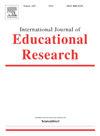Characteristics of primary school mathematics classroom discourse for cultivating higher-order thinking: Analysis based on classroom videos of Chinese primary school expert teachers
IF 2.6
3区 教育学
Q1 EDUCATION & EDUCATIONAL RESEARCH
引用次数: 0
Abstract
Classroom discourse is an important medium for cultivating higher-order thinking, which in turn is the value orientation of classroom discourse reform. To reveal the classroom discourse rules for students’ thinking progress and refine the classroom discourse characteristics for the cultivation of students’ higher-order thinking, this study conducted a combination of qualitative and quantitative, static and dynamic analyses of teacher-student discourse in the classrooms of Chinese primary school mathematics expert teachers from four dimensions of discourse opportunity, discourse form, discourse function and dialogue mechanism, aiming at presenting the thinking orientation of discourse, tracing the progression of students’ thinking, and exploring how teachers implement discourse interactions to advance thinking. The findings revealed that in primary school mathematics classrooms oriented towards the cultivation of students’ higher-order thinking, both expert teachers and students co-created and co-shared equal and sufficient discourse opportunities, and students visualized their thinking in multiple interactions; expert teachers only issued a limited number of higher-order questions that triggered discussion and followed up with guided feedback on students’ responses, so that students’ thinking collided with each other's responses; and expert teachers constructed discourse chains based on students’ rememberable responses and scaffolded by timely follow-up questions to help students advance their thinking.
求助全文
约1分钟内获得全文
求助全文
来源期刊

International Journal of Educational Research
EDUCATION & EDUCATIONAL RESEARCH-
CiteScore
6.20
自引率
3.10%
发文量
141
审稿时长
21 days
期刊介绍:
The International Journal of Educational Research publishes regular papers and special issues on specific topics of interest to international audiences of educational researchers. Examples of recent Special Issues published in the journal illustrate the breadth of topics that have be included in the journal: Students Perspectives on Learning Environments, Social, Motivational and Emotional Aspects of Learning Disabilities, Epistemological Beliefs and Domain, Analyzing Mathematics Classroom Cultures and Practices, and Music Education: A site for collaborative creativity.
 求助内容:
求助内容: 应助结果提醒方式:
应助结果提醒方式:


